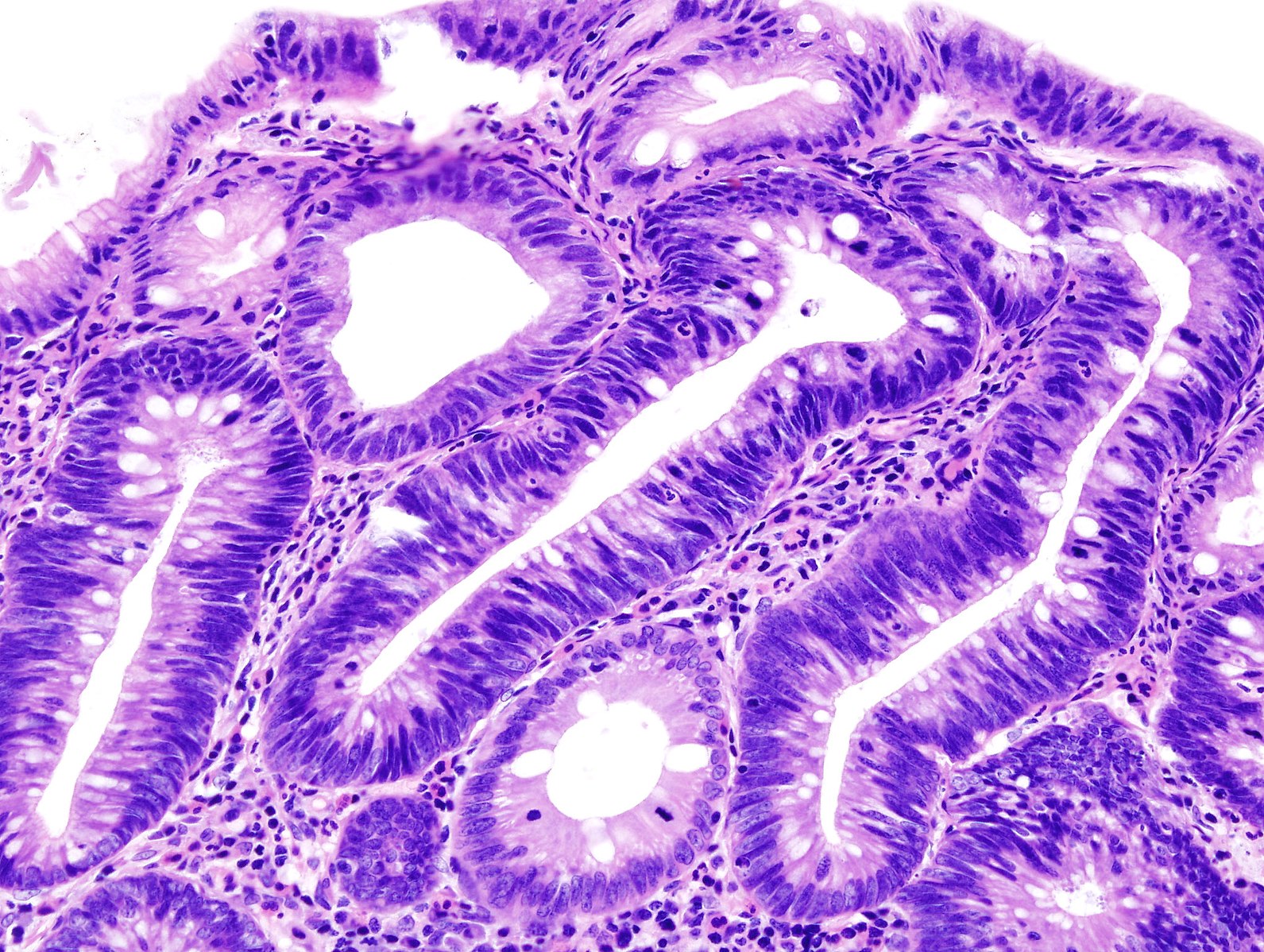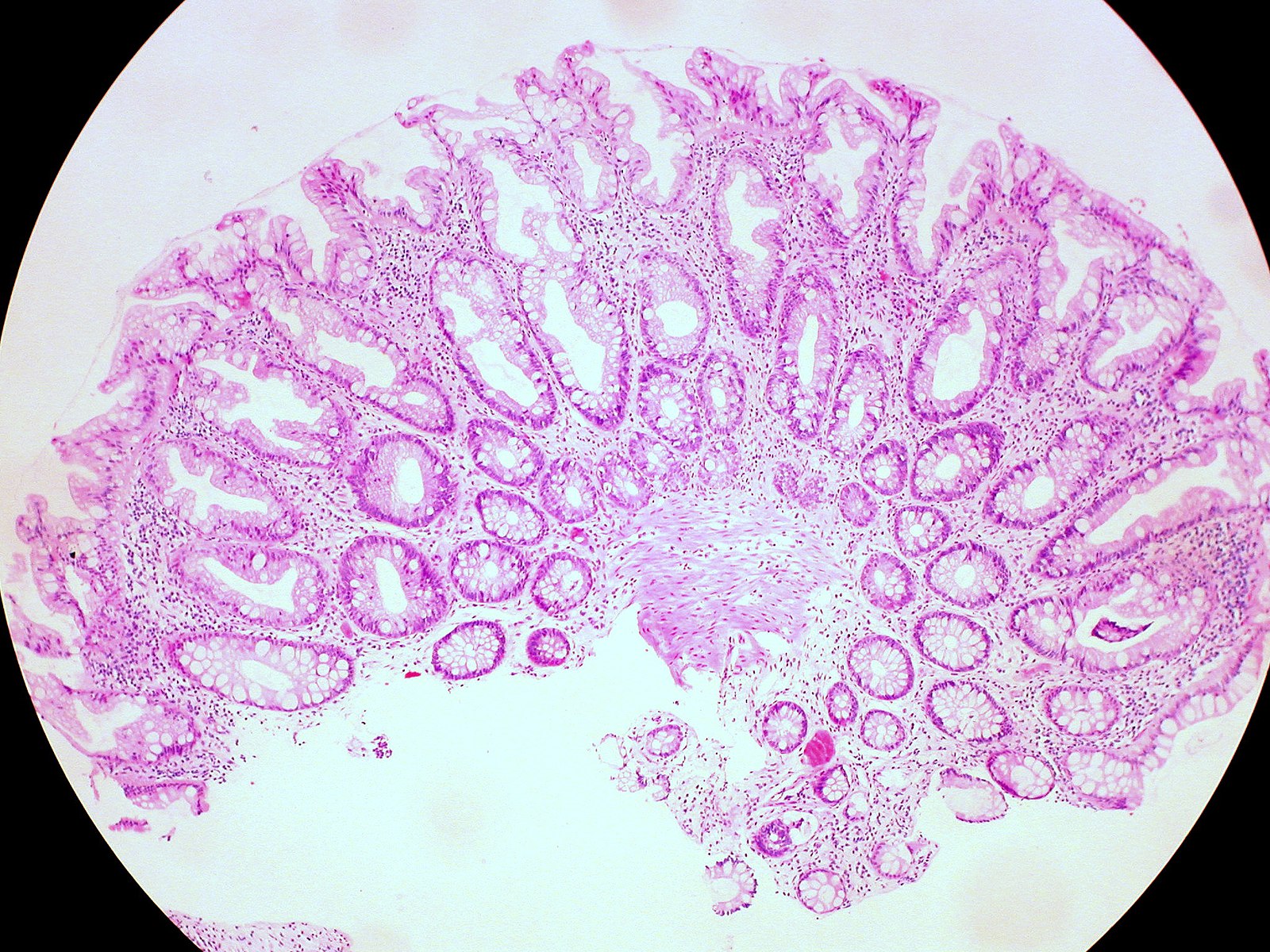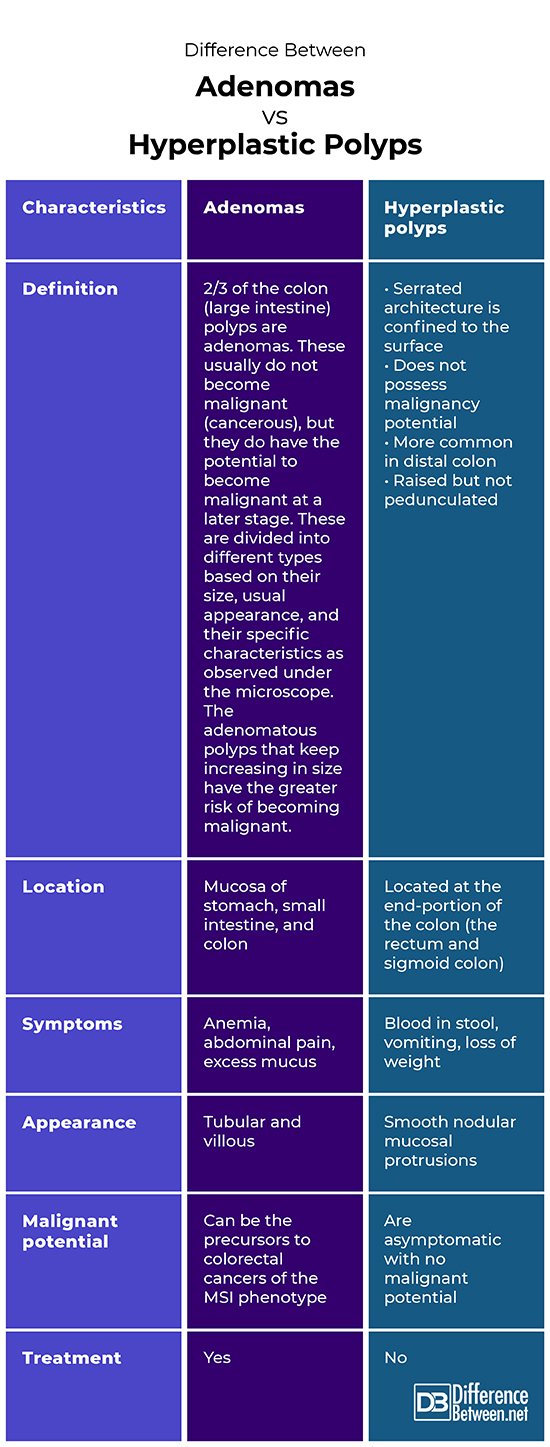Difference Between Adenomas and Hyperplastic Polyps
What are adenomas and hyperplastic polyps?
Both adenomas and hyperplastic polyps are two types of polyps (abnormal tissue growth on a mucous membrane like colon or endometrium). Adenomatous polyps have the potential to become malignant (cancerous). However, hyperplastic polyps have least probability of becoming malignant (cancerous)
Similarity
Both adenomas and hyperplastic polyps are types of polyps

Adenomas
Adenomatous polyps are the most common type of polyps. These appear gland like extensions that grow or develop on the mucous membrane (he moist, inner lining of some organs and body cavities) that lines the large intestine (colon). These are also termed as adenomas and are of three types – tubular, villous and tubulovillous

Hyperplastic polyps
Hyperplastic polyps occur in your colon or large bowel – the lining of larger intestine. A hyperplastic polyp is usually benign and is an extension or a growth of extra tissues which grow out from existing tissues in the body. They grow in areas in the body where there are repaired tissues which were damaged at some point especially along your digestive tract.
Difference between adenomas and hyperplastic polyps
Definition
Adenomas
Polyps that become malignant over a period of time are termed as adenomas or adenomatous polyps
Hyperplastic polyps
Polyps that possess the least chance of becoming malignant or cancerous are termed as hyperplastic polyps.
Microscopical appearance
Adenomas
Dysplastic cytologic features of an adenoma
Hyperplastic polyps
Saw-toothed epithelial pattern representing micropapillary luminal infoldings of columnar absorptive cells
Macroscopically
Adenomas
Can be more than 1 cm
Hyperplastic polyps
Less than 1 cm
Risk factors
Adenomas
People are more likely to develop colorectal cancer if they:
- Are fat (obese)
- Smoke cigarettes
- Lack of physical activity and exercise
- Eat too much processed and red meat
- Consume too much alcohol
- Have type 2 diabetes
Hyperplastic polyps
If happens in colon, certain risk factors include;
- Being too fat (obese)
- Being male
- Consuming a lot of red meat
- Not enough physical activity and exercise
- Too much tobacco smoking
- Heavy alcohol consumption
- Bowel condition with inflammation (diseases called Crohn’s disease)
- Presence of polyps in the right (ascending) colon
If happens in the stomach, the risk factors include;
- Possessing a stomach infection due to Helicobacter pylori bacteria
- Possessing a genetic medical history of malign (cancerous) stomach polyps
- Usage of medication like proton pump inhibitor for stomach acid
Types
Adenomas
- Tubular – Small, pedunculated polyps composed of tiny, rounded or tubular glands and protrudes out in the lumen (channel within a tube or tubular organ) of the colon
- Villous – larger and sessile, enveloped by slender. The growths are lined by dysplastic glandular epithelium (expansion of immature cells) whose risk of cancer is especially high up to 50%
- Tubulovillous – polyps containing >25% of both tubular and villous adenomas
Hyperplastic polyps
- Pedunculated – long in size and narrow with a stalk that is mushroom like
- Sessile – smaller/tinier and squat-looking
- Serrated – Wider near the bottom, short and flat above
Location
Adenomas
Proximal to rectosigmoid junction
Hyperplastic polyps
Distal to rectosigmoid junction
Treatment and surveillance
Adenomas
Requires treatment and surveillance
Hyperplastic polyps
Does not require treatment and surveillance
Summary
The points of difference between adenomas and hyperplastic polyps have been summarized as below:
Difference between adenomas and hyperplastic polyps

FAQ
Is a polyp the same as an adenoma?
Polyp is a tiny cell-clump or an abnormal tissue growth inside different organs (such as colon) inside a body on a mucous membrane and adenoma is a type of polyp which is mostly harmless but some could develop malignancy (Cancer)
What is the difference between adenomas and hyperplastic polyps?
Both are types of polyps. Adenomas could become precancerous. Hyperplastic polyps possess no malignant potential
Do all adenoma polyps become cancer?
No. Only a tiny percent actually develops malignancy (become cancerous), buy most of the cancerous (malignant) polyps began as adenomatous. However, the process for these polyps to become malignant into colon cancer usually takes a lot of years.
What is an adenoma?
An adenoma is a polyp that comprises of cells and tissue that appear similar to the normal colon lining, although it is completely different in multiple characteristics when assessed and seen under the microscope. Adenoma polyps, in some cases give birth to cancer cells.
What foods cause polyps?
Foods that can cause inflammation are the ones that could cause polyps and these include red meat (pork and beef), fried items that contain fatty acids, processed meat which includes lunch meats, processed bacon, processed chicken and lamb, sausages and hot dogs.
Do adenomas grow back?
Yes, adenomas possess recurring capacity. Smaller polyps are not noticeable and go away on their own. However, some adenomatous polyps could be precancerous.
- Difference Between Global Warming and Greenhouse Effect - May 18, 2024
- Difference Between Vaccination and Immunization - March 3, 2024
- Difference Between Selective Mutism and Autism - February 25, 2024
Search DifferenceBetween.net :
Leave a Response
References :
[0]Jass, J. R., & Burt, R. (2000). Hyperplastic polyposis. Pathology and genetics of tumours of the digestive system, 135.
[1]Jaravaza, D. R., & Rigby, J. M. (2020). Hyperplastic polyp or sessile serrated lesion? The contribution of serial sections to reclassification. Diagnostic Pathology, 15(1), 1-9.
[2]Levine, J. S., & Ahnen, D. J. (2006). Adenomatous polyps of the colon. New England Journal of Medicine, 355(24), 2551-2557.
[3]Liljegren, A., Lindblom, A., Rotstein, S., Nilsson, B., Rubio, C., & Jaramillo, E. (2003). Prevalence and incidence of hyperplastic polyps and adenomas in familial colorectal cancer: correlation between the two types of colon polyps. Gut, 52(8), 1140–1147. https://doi.org/10.1136/gut.52.8.1140
[4]Image credit: https://commons.wikimedia.org/wiki/File:Colon_adenoma_(1).jpg
[5]Image credit: https://commons.wikimedia.org/wiki/File:Hyperplastic_Polyp_of_the_Rectum_(14060044206).jpg
